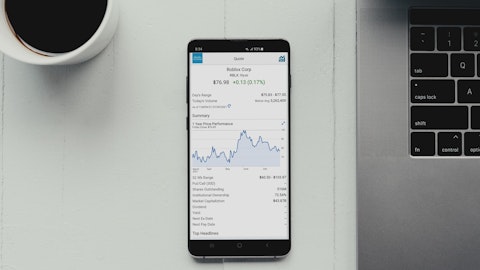Steven Frankel: Good afternoon. So, as we think about the growth trajectory that you’re talking about for Vision, Atmos and patents. It’s a little slower, obviously less slower than last year, little slower than I think everyone was expecting. To what extent is it this uncertain environment that’s either causing design decisions to be delayed or customers to hesitate adding those premium technologies because it’s going to raise the cost of the build materials?
Kevin Yeaman: Yes. Well, we still see great demand for people that — for adoption of technologies. And like I said, just in the last few weeks, we’ve added Polestar, Lotus, Volvo on the automotive side. And yes, we did come in a little bit lower than the expectation we set last quarter. We did have a couple of engagements that it took longer, but we grew 30%, and that’s on the strength of movies and TV. Remember, it was also driven by the improvement in the box office for Dolby Cinema, which continue to that growth next year, but probably not the level of box office improvement that we have coming off of those pandemic lows. And so at 15% to 25% we are allowing for a range of outcomes in that guidance because we see — we continue to see great demand signals across each of the areas we talked about. At the same time, we recognize that we have been seeing engagements take a little longer. So, we allowed for that in our range of outcomes.
Steven Frankel: Okay. So just to refine that a little further, you’re not necessarily getting pushback because of the incremental cost. It’s more about the demand picture and decision cycles.
Kevin Yeaman: Yes. Yes. I think that’s a fair. So, what we’re not seeing is slowdown in people wanting to adopt. We’re not getting slowed down by the — price is not the reason we’re slowing down. It’s just an environment where everybody is affected by this, in some way, shape or form and that can affect the time it takes to get transaction cycles done. I mean for — as Robert said earlier, as you know, our licensing business is based on unit shipments. And in general, where our revenue comes in, we estimate what shift each quarter, and trued up the next quarter. To the extent that those engagements are delaying, more often than not, it means that we might be signing it fewer months before the first shipment than we might have.
But for some of these other things like past units or deciding on minimum equipment volumes, that is where I think there’s a lot of tension cycles as people look at how all of this affects their business. And so some of those engagement cycles are taking longer.
Steven Frankel: Okay. And then for Robert, what was the true-up in the quarter?
Robert Park: The true-up in the quarter is about $3 million.
Steven Frankel: To the positive side.
Robert Park: To the positive, yes.
Steven Frankel: Yes. So similar to Q3.
Robert Park: Yes.
Steven Frankel: Okay. And are you getting any pushback from customers around the notion of fixed minimum payment contracts in this environment?
Kevin Yeaman: Looks, I don’t think we’ve seen pervasive pushback on the notion of the volume commitments. I mean as far as we’re concerned, essentially, it’s about being on those devices and how many are going to ship. And whether they’re doing minimum value commitments tend to affect the timing of when it comes in, right? It’s pretty rare that someone would ever commit to more than they are sure they can ship. So, I think that it’s not a significant driver to what we’ve seen, but it’s — there are some that are thinking about what minimums they want to commit to given the uncertainty they’re facing. But from a Dolby perspective, that’s just a matter of the timing of when that comes in, right? And I also want to add, Steve, to your previous question.





